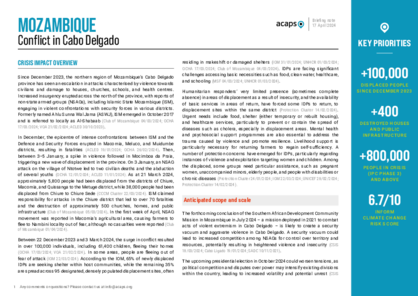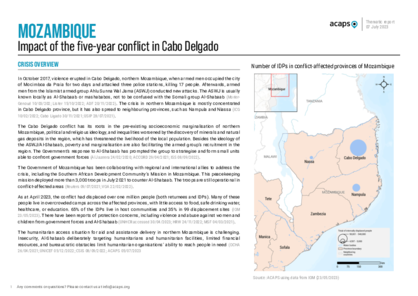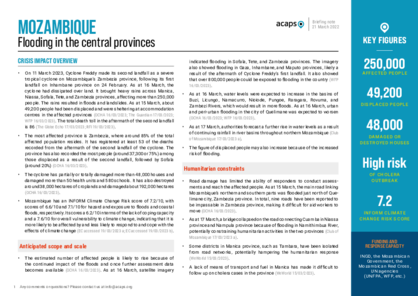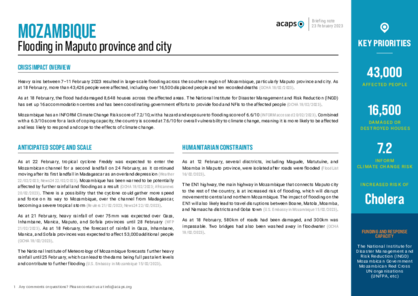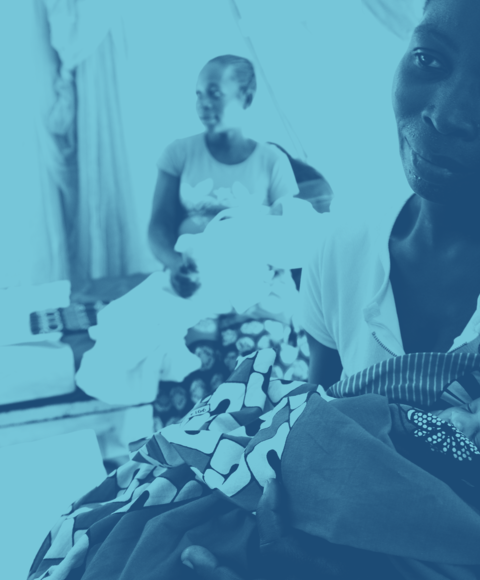Latest updates on country situation
19 March 2024
On 12 March 2024, Tropical Storm Filipo hit Inhambane province in southern Mozambique. As at 15 March, the storm had affected over 48,000 people in the provinces of Gaza, Inhambane, Maputo, and Sofala. The area dealing with the most impact is Maputo city, with 25,455 people affected. The storm has also caused significant infrastructure damage, destroying or damaging approximately 8,000 houses and affecting 146 schools (22,442 students), 51 health centres, 56 electric poles, and 19 roads. The impact of the storm has the potential to aggravate food insecurity, worsening the IPC projection of 3.3 million people facing Crisis (IPC Phase 3) or worse levels from October 2023 to March 2024. The floods, as well as El Niño-induced dry spells, have also affected crops during the planting season. The highest needs are education, shelter/NFIs, water purification, and hygiene kits. (OCHA 15/03/2024, IPC 28/11/2023, ABC 14/03/2024)
05 March 2024
Between 22 December 2023 and 3 March 2024, attacks and fear of attacks by non-state armed groups displaced approximately 113,000 people from Chiure, Ibo Island, Macomia, Mecufi, Mocimboa da Praia, and Muidumbe districts. The majority (62%) of the displaced were children, followed by women (23%) and men (13%). As a precautionary measure, on 3 March, major NGOs began evacuating their personnel from Ibo Island when the armed groups occupied and controlled Quirimba Island, a section of the same municipality located less than 15km away. Affected and displaced people require immediate attention, including health services and counselling to cope with the loss of family and property. Urgent needs include food, shelter, and NFIs. (IOM 05/03/2024, Club of Mozambique 04/03/2024, MSF 04/03/2024)
13 February 2024
Since January 2024, Cabo Delgado province has been experiencing increased attacks and activities from non-state armed groups. Over 10,000 people were displaced across villages in Macomia, Mecufi, Mocimboa da Praia, and Muidumbe districts from 26 December 2023 to 7 February 2024. They urgently need food, shelter, and NFIs. (ICG accessed 14/02/2024, IOM 08/02/2024, Club of Mozambique 12/02/2024)
06 February 2024
Between 22 January and 2 February 2024, attacks and fears of further attacks displaced 2,621 people in villages across Mecufi and Macomia districts of Cabo Delgado province, affecting children the most. The displaced are sheltering in displacement centres in the districts of Macomia, Metuge, and Mueda and urgently require food, health assistance, and NFIs. (IOM 03/02/2024)
13 November 2023
From 10-12 November 2023, more than 800 people were displaced in the Macomia district of Cabo Delgado, following attacks by non-state armed groups. The displaced people are sheltering in resettlement sites and among host communities in the Changane, Nanga A, and Napulubo neighbourhoods. Children and women are the most affected and the priority needs for the affected are food, shelter and NFIs.
06 October 2023
Between 14–23 September 2023, non-state armed groups attacked Macomia, Mocimboa da Praia, and Muidumbe districts in northeastern Cabo Delgado province. The attacks displaced at least 7,000 people, killed 11 civilians, led to the abduction of an unknown number, and burnt several houses. Those displaced are sheltering in schools or with relatives. Funding inadequacy continues to hinder an effective humanitarian response. (ECHO 06/10/2023, OCHA 05/10/2023)
12 September 2023
Between July–August 2023, IOM identified more than 850,000 IDPs and 571,000 returnees in 325 locations across northern and central Mozambique. Children under 18 years comprise 49% of those affected, women comprise 30%, and men 21%. Of the IDPs, 55% are living in host communities, while 45% are in 191 displacement sites. Priority needs include income sources, NFIs, shelter, health, food, and WASH services. (IOM 12/09/2023, IOM 11/09/2023)
current crises
in
Mozambique
These crises have been identified through the INFORM Severity Index, a tool for measuring and comparing the severity of humanitarian crises globally.
MOZ001 - Multiple Crises
Last updated 17/04/2024
Drivers
Conflict
Displacement
Cyclone
Crisis level
Country
Severity level
3.7 High
Access constraints
4.0
MOZ004 - Violent Insurgency in Cabo Delgado
Last updated 17/04/2024
Drivers
Conflict
Displacement
Crisis level
Country
Severity level
3.7 High
Access constraints
4.0
Analysis products
on
Mozambique
07 July 2023
Mozambique: impact of the five-year conflict in Cabo Delgado
DOCUMENT / PDF / 615 KB
In October 2017, violence erupted in Cabo Delgado, northern Mozambique, when armed men occupied the city of Mocimboa da Praia for two days and attacked three police stations, killing 17 people. The report aims to analyse the drivers of conflict in northern Mozambique, particularly in Cabo Delgado province, and their humanitarian impact. The report also includes an overview of people’s coping mechanisms following the conflict.
21 March 2023
Mozambique: Flooding in the central provinces
DOCUMENT / PDF / 318 KB
On 11 March 2023, Cyclone Freddy made its second landfall as a severe tropical cyclone on Mozambique’s Zambezia province. It brought heavy rains across Manica, Niassa, Sofala, Tete, and Zambezia provinces, affecting more than 250,000 people.
23 February 2023
Mozambique: flooding in Maputo province and city
DOCUMENT / PDF / 1 MB
Heavy rains between 7–11 February 2023 resulted in large-scale flooding across the southern region of Mozambique, particularly Maputo province and city. As at 18 February, more than 43,000 people were affected, including over 16,500 displaced people and ten recorded deaths.
22 December 2022
Ripple effects of the conflict in Ukraine: truths and myths
DOCUMENT / PDF / 4 MB
This report provides a commentary on relevant datasets as it examines trends related to the economic effects of the 2022 Russian invasion of Ukraine on selected countries in the Middle East, Africa, and Asia.


